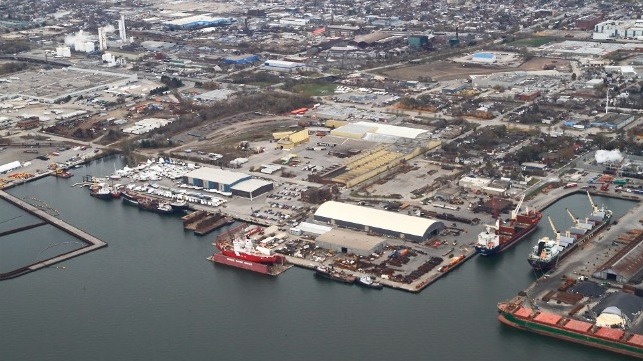Prospects for Automation in Inland Waterway Transport

Much research and development is currently underway involving automation in the transportation industries and including in container freight movement. Automated cranes already load and off-load containers at several major international ports while development of automated operation of freight carrying trains and trucks is well underway. Introducing automated navigation and automated container transfer operations along inland waterways promises to reduce container transportation costs to small ports located along such waterways.
Introduction
The future of container transportation will involve increased application of automated technology that includes vessel navigation, transfer of containers between ship and shore and also between ship and surface-based transportation. Tests are underway involving computer driven trucks along some American roadways. Automated cranes can operate at major terminals while scaled down variations of such cranes could be installed about ship to provide service to quaysides where cranes are absent. While automated ocean-going ship navigation is well underway, there is scope to develop automated navigation for commercial vessels that sail along the inland waterways.
At the present time, crane equipped combination general cargo and container ships sail the trans-North Atlantic service between western European ports and Cleveland on Lake Erie. While a port processing a large number of containers would justify the investment into specialized dockside cranes to service large ships, the arrival of small numbers of containers at small ports may not justify the cost of investing in specialized crane equipment to transfer containers. The option of crane-equipped ships with automated crane operation offers the potential to provide cost-competitive container delivery service to small ports.
Automated Port Vehicles
While automated port vehicles already move containers around some major international ports, there is scope to introduce port vehicle operational software into automated trucks developed to operate intercity and urban service. Line-ups of such trucks could await the scheduled arrival of automated crane-equipped container ships at small ports located along inland waterways. Communication between automation systems would facilitate the quick and reliable transfer of containers from ship to truck at the inland ports and at much lower cost than earlier, more time consuming manually operated technology. Automation provides container transfer opportunity for small ports located along inland waterways.
Container-on-barge operation is underway and growing along the American inland waterway system, also along the European barge canal system and even along navigable South American waterways. Small ports located along the American waterway system represent an area of future growth and development in the automated transfer of containers between waterway and road vehicles. There may be opportunity to develop larger container barges equipped with onboard automated cranes to transfer containers while at port, with the alternative option of introducing automation to port-based picker vehicles that transfer containers between barge and truck.
Market Niches
The majority of containers that move internationally aboard large ships are transferred to trains and trucks at major ports. A small percentage of containers are transferred between ocean vessels and inland waterway vessels, at ports such as New Orleans, Rotterdam and Buenos Aires. In a few isolated cases, small ships that sail across ocean also sail to ports located along inland waterways as is the case between Western Europe and Lake Erie. Tug-barge inland waterway vessels are cost competitive against railways when carrying over 100-TEU and against trucks when carrying over a dozen TEU.
Customers seeking to save on transportation costs and are willing to delay arrival of their containers for a few days have the option of using the combination of ocean ships and inland waterway transportation. Some environmentally conscious customers have recently had their containers carried across the North Atlantic aboard wind-powered vessels. However, the extreme height of some wind-powered vessels precludes their passing under bridges. Such container carrier vessels would have wind turbines installed near the vessel stern, with the turbine extreme upper level reaching up to 100-m above ocean surface.
St. Lawrence Seaway
Automated container transfer technology offers the possibility of reducing container transportation costs along the St. Lawrence Seaway and especially for vessels sailing across the North Atlantic. The present length of container vessels that sail to Cleveland is 456 feet, or over 12 TEU lengths shorter than maximum size Seaway-max ships. While one of the container vessels can only carry seven TEU widths within its hull, its companion can carry eight TEU widths. A Seawaymax ship can carry nine TEU widths. There is likely market potential for a self-unloading crane equipped Seawaymax container ship to carry containers from Europe to both Cleveland and Toronto.
At the present time, there is great reluctance within the domestic Canadian ship transportation industry to operate tug-barges carrying containers along the St. Lawrence River and Seaway. Regulation actually results in self-powered ships being more costly to operate while carrying the same payload as a tug-barge. The future opening of Port of Quebec City container terminal offers the option of automated tug-barges with onboard cranes to interline with large ocean-going container ships and provide cost-competitive per container transportation service to small ports located along the lower and upper sections of the St. Lawrence River and its tributaries.
Conclusions
Technology is under development that would make automated container vessel operation possible along navigable inland waterways. Such automation would include vessel navigation and the operation of onboard deck-mounted cranes that allow the vessel to self-load and self-unload. Automated self-driving trucks would interline with automated waterway vessels at small ports, to transfer containers quickly and at low cost. Automation that reduces operating costs would also enhance the operation of a larger container ship that could connect between Western Europe and the ports of Cleveland and Toronto, if Canadian regulators allow for such operation.
The opinions expressed herein are the author's and not necessarily those of The Maritime Executive.
